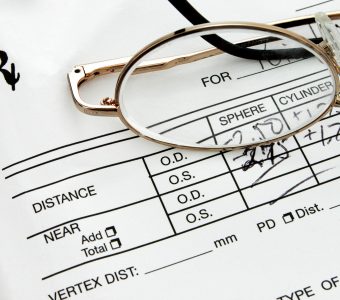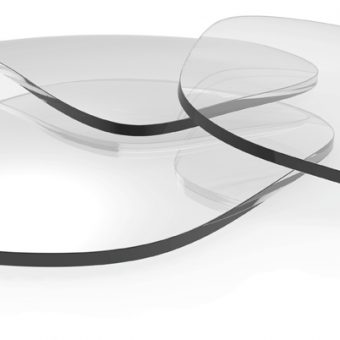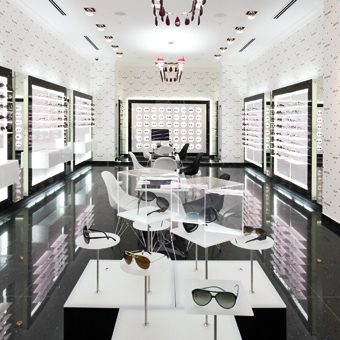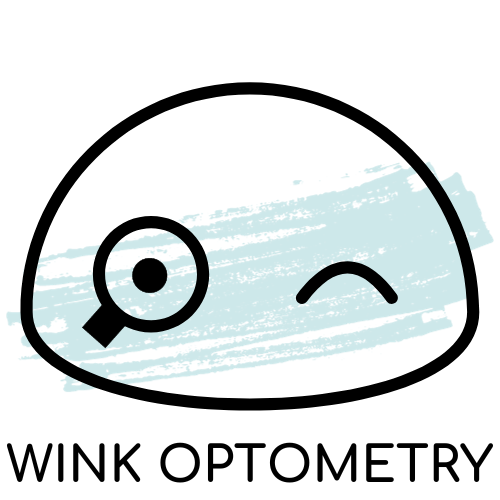Ever since the whole buying glasses online box was opened, there has been a decline in product quality and in turn a loss of trust from the consumers in the ability of retailers to provide good quality products. Because really, how do you know you’re not getting ripped off? Why is there such a big difference between online lenses, box store (Lenscrafters, Pearl Vision, Walmart, Costco, etc.) lenses, and branded lenses (ie. Nikon, Essilor, Zeiss, Hoya, etc.). What makes it worth it to spend hundreds of dollars versus less than $100 on a pair of lenses? Ultimately, it’s about what you think (after being educated) is worth it for you and what your needs are.
 What you can’t change – your prescription. This highly affects what lenses you should or shouldn’t be buying. If your prescription is higher than a + or – 4.00D or you have more than -1.25D of astigmatism I would stay away from online retailers (this is a personal opinion based on my past experiences working with online retailers). This is based purely on the fact that there is no guarantee that the online retailers are able to manufacture your prescription correctly based on only 1 measurement (PD) alone. The higher the prescription, the more sensitive you are to changes. If the lenses are decentered, the clarity of your vision and comfort are being compromised. Online retailers use majority stock lenses for their products – meaning the lens isn’t custom made to the patient’s prescription for the selected frame (they are not surfaced). Stock lenses are mass produced – no customizations. For lower prescriptions, this is usually fine as the tolerance to inaccuracies and decentration is higher (errors are more tolerable). This is how they can afford to sell lenses for lower prices, they are not paying for the surfacing/customization of the lenses for their customers and only use one measurement so the stock lenses will always “fit” into the selected frames. On the opposite spectrum, when you pay for surfaced lenses (lenses that are made for you in your prescription for your frame selection), you are paying the premium prices for that extra step that is taken to ensure the accuracy of your prescription is where it should be in the lens. Also, premium brands have other options available for lenses to further reduce the distortion and increase the clarity of lenses through digital surfacing and other new technologies not available to online retailers (there’s a reason none of the premium lens manufacturers offer their products online). So if your prescription is low enough, it is fine to purchase lenses online without having to worry too much about compromising the quality; however, if your prescription is higher, you will be risking the accuracy and quality of the lenses by purchasing online.
What you can’t change – your prescription. This highly affects what lenses you should or shouldn’t be buying. If your prescription is higher than a + or – 4.00D or you have more than -1.25D of astigmatism I would stay away from online retailers (this is a personal opinion based on my past experiences working with online retailers). This is based purely on the fact that there is no guarantee that the online retailers are able to manufacture your prescription correctly based on only 1 measurement (PD) alone. The higher the prescription, the more sensitive you are to changes. If the lenses are decentered, the clarity of your vision and comfort are being compromised. Online retailers use majority stock lenses for their products – meaning the lens isn’t custom made to the patient’s prescription for the selected frame (they are not surfaced). Stock lenses are mass produced – no customizations. For lower prescriptions, this is usually fine as the tolerance to inaccuracies and decentration is higher (errors are more tolerable). This is how they can afford to sell lenses for lower prices, they are not paying for the surfacing/customization of the lenses for their customers and only use one measurement so the stock lenses will always “fit” into the selected frames. On the opposite spectrum, when you pay for surfaced lenses (lenses that are made for you in your prescription for your frame selection), you are paying the premium prices for that extra step that is taken to ensure the accuracy of your prescription is where it should be in the lens. Also, premium brands have other options available for lenses to further reduce the distortion and increase the clarity of lenses through digital surfacing and other new technologies not available to online retailers (there’s a reason none of the premium lens manufacturers offer their products online). So if your prescription is low enough, it is fine to purchase lenses online without having to worry too much about compromising the quality; however, if your prescription is higher, you will be risking the accuracy and quality of the lenses by purchasing online.
 Lens materials – another factor in the variance in pricing is what the lenses are made out of. Although majority of lenses now a day are plastic, it makes a difference where these plastics come from. Did you know Nikon was the first company to create the thinnest plastic (1.74 lens index) available on the market today? This material is widely unavailable on the online platform – only people with super high prescriptions would require this material though (+/- 6.50 or higher). The higher the lens index, the thinner the lens. So although people with prescriptions around +/- 6.00D can get lower index lenses, they will be quite thick and heavy. My prescription is -6.50 in both eyes and I prefer to have the 1.74 lens index mainly for comfort reasons – not a necessity. All of the materials for Nikon lenses is manufactured in Japan (I’m not sure about the other brands; however, Essilor is French, Zeiss is German, and Hoya is also Japanese). Online retailers mostly use the cheapest lenses available which majority are manufactured and imported from China. I can assure you that premium brands are not buying from the same manufacturers and simply adding their label to the lens to jack up the prices. Although the same cannot be said of box store opticals.
Lens materials – another factor in the variance in pricing is what the lenses are made out of. Although majority of lenses now a day are plastic, it makes a difference where these plastics come from. Did you know Nikon was the first company to create the thinnest plastic (1.74 lens index) available on the market today? This material is widely unavailable on the online platform – only people with super high prescriptions would require this material though (+/- 6.50 or higher). The higher the lens index, the thinner the lens. So although people with prescriptions around +/- 6.00D can get lower index lenses, they will be quite thick and heavy. My prescription is -6.50 in both eyes and I prefer to have the 1.74 lens index mainly for comfort reasons – not a necessity. All of the materials for Nikon lenses is manufactured in Japan (I’m not sure about the other brands; however, Essilor is French, Zeiss is German, and Hoya is also Japanese). Online retailers mostly use the cheapest lenses available which majority are manufactured and imported from China. I can assure you that premium brands are not buying from the same manufacturers and simply adding their label to the lens to jack up the prices. Although the same cannot be said of box store opticals.

Lens coatings – there is a huge difference in quality here when it comes to online retailers and premium brands. My experience with online retailers has proven time and time again that their coatings are inferior by far. They craze (break down) before they should and don’t provide optimal viewing experiences (they’re hard to clean and often hinder vision rather than enhancing). Although they may claim to provide the same benefits as premium brands (anti-reflective, anti-glare, anti-scratch, repel dirt, dust, and oils, anti-static, easy-clean, or blue-blocking), I would be highly skeptical of how adequate the coatings are. It is a long process for the premium lens manufacturers to apply these coatings to the surfaced lenses to ensure they adhere properly. Online retailers buy their lenses stock so they are not in control of this process and cannot guarantee the quality. Many companies claim to have a “blue-blocking” coating for their lenses, but it is important to note that all of them are not the same. Premium brand coatings put more money into research and development to ensure their coatings are doing what they claim without compromising the esthetics of the lens. Cheap blue-blocker coatings will have a very evident blue tinge in almost any light versus premium ones aim to only block the harmful blue light (not all blue is bad) so will appear more transparent/visually appealing (their coatings are more selective in the blue light they are blocking vs. “all blue light” in the cheaper versions).
 Availability. Where the products are available will show you the quality as well (as long as you’re not buying fakes). Premium lens manufacturers will only allow certain opticals and optometrists to sell their products as they don’t want their products to be misrepresented in the market. You will notice that all box store opticals will not have theses products either – they sell unbranded or widely available lenses. And they will definitely not be available online (ie. Clearly.ca is owned by Essilor Group but by no means do they sell Essilor’s Varilux lenses). So when you’re buying from your local optometrist, you’re paying for their professional opinion on which lens is best suited for your needs and knowing that you will get the best. All premium brand lenses should come with an authenticity card – if you didn’t get it then it might be a fake.
Availability. Where the products are available will show you the quality as well (as long as you’re not buying fakes). Premium lens manufacturers will only allow certain opticals and optometrists to sell their products as they don’t want their products to be misrepresented in the market. You will notice that all box store opticals will not have theses products either – they sell unbranded or widely available lenses. And they will definitely not be available online (ie. Clearly.ca is owned by Essilor Group but by no means do they sell Essilor’s Varilux lenses). So when you’re buying from your local optometrist, you’re paying for their professional opinion on which lens is best suited for your needs and knowing that you will get the best. All premium brand lenses should come with an authenticity card – if you didn’t get it then it might be a fake.
At the end of it, it’s what you think is worth your money. Premium lens manufacturers will always cost more – they are not going to reduce their prices to be competitive with lenses that cost a fraction of the price it costs them to make their lenses. In my experience and having a higher prescription, I have happily invested my money in premium brands (Nikon specifically because I haven’t had much experience with the other brands as of yet) and not regretted that choice.


I found this INFO very helpful and informative, Well researched and laid out
Buying Glasses is a mine field and it’s not easy to come out the other side with a product that’s whats best for you
Apart from spelling “Availabiltiy” wrong above, this was a good post. I want the trifecta – big, full progressive transitions so I’m not swapping glasses going in and out of doors in summer. With my tiny PD and a big frame, a first fitting of top of the line Zeiss Individual 2 didn’t work (in this case the optician only sold Zeiss). Professional opinions between whether it was too big a frame for my PD, or simply the wrong lens choice that was to blame – were divided. I’m about to explore other lenses with the same frame, to see if it makes a difference.
Thanks for pointing out the spelling error! Trying a different design will definitely make a difference for you. Everyone’s brain is different so just because one lens works for one person, doesn’t mean it’ll work for another. I would try a Nikon (SeeMax Emblematic is their top of the line right now) or Hoya (iD MyStyle 2) progressive if you haven’t yet! We’ve had lots of success with those 2 lenses. Let us know how they work out!
Hi Natasha. I’m about to purchase new glasses and was just wondering if you think that the Nikon HD progressive lenses are an excellent choice? I’ve also been told that Varilux is good. I have astigmatism and a strong prescription to correct my sight. My last pair of glasses were awful…the actual viewing area, I discovered later on, was just in the center of the glasses. I want to make an intelligent choice this time.
Hi Joanna,
Nikon and Varilux are both good products. It’s tough with progressives because there isn’t one lens that works the best for everyone. They all have different designs and certain designs will work better for certain people. Do you know exactly which Nikon/Varilux lens you were advised to try?
Thank you for the informative article. I’m 46 and in the last year and a half I experienced a significant deterioration in my sight with the onset of presbyopia. I’m a graphic designer, working in vector, often with tight lines, curves, and a need for high accuracy in my sight. My prescription is +5.25 in my right eye, with -1.25 astigmatism (axis 165 deg), and +6.5 in my left. I’m willing to spend any amount of money for the absolute best optical solution, and I will only stick with Nikon, but I’m very confused as to what lens exactly is best for me. Should I go with Nikon Seemax Emblematic (I’ve never had progressives before, and I’m concerned but having to move my head around to get the vision support I need at close distances; I also really need to look through the centre of the lens for computer work), or should I go with single focus lenses for everyday life (which in the Nikon range, I’m really not sure), and something like Nikon’s Online Wide Neo for computer work? I honestly cannot find enough information to make an informed choice. Any thoughts would be greatly appreciated.
Hi Ian,
Thank you for reaching out to us! The Nikon Emblematic progressive is definitely top of the line. However, as a graphic designer you spend long hours in front of a screen/screen(s) that are at set distances. I would recommend going with a single vision computer prescription so that the whole lens can be utilized for computer viewing. Progressives are great for everyday things but when it comes to needing wide viewing areas for specific tasks for long periods of time, they can be cumbersome and limiting. Like you mentioned, the head tilting and finding the sweet spot can be mildly annoying. Do you have any closer paper work that you need to change focus to look at for work? If yes then the Online Wide may be a better choice to switch focus points from screen to paperwork. Keep in mind though that because there is more than one prescription in the lens there will be distortion areas that are not optimal vision. If you’re in the area we’d be more than happy to help you in person 🙂 Hope this helps you though!
Hi Natasha, I am looking for info and a comparison of myopia control lenses (Essilor vs Zeiss) for my 12 year old child who’s prescription is -1 & -1.25. Is one brand more effective than the other?
Hello! Sorry for the late reply. As far as myopia control goes, there is no research on which lens works the best. Each lens manufacturer has their own version of myopia control lenses. In my opinion, it really depends on how the child uses their eyes when they are doing things up close. Both designs compensate for the internal changes happening and should help to counteract the actions that contribute to myopia advancement. Going with either one should be beneficial for the child. Different designs simply work better for certain people and how their eyes converge when doing near work. Hope this is helpful!
Hi, I have very high prescription -10 and -9. I have little astigmatism too. I usually wore Nikkon glass lens but am now an elderly and want to change to plastic. I wanted Nikkon progressive lens but my optician does not stock these so I went for Ziess. Her supplier is currently struggling to get these and I have been suggested to go for Hoya. I am a little reluctant as I understood Hoya is inferior quality to Zeiss or Essilor. Your advice will be greatly appreicated. Thanks.
Hello! You should be able to get progressives in your prescription for all of those brands. I wouldn’t say one is inferior to the other. They are all great manufacturers – just different designs that suit different people. It’s hard to determine which one is better for you without having your try the designs or having previous experience with them. Also the frame selection will make a difference as well.
I’ve had problems with several pairs of varifocal glasses over the years mainly in keeping them clean! I generally clean them with optical cloths many many times a day. They smear very easily which distorts my vision. I wear my glasses all the time and work at a computer daily. I don’t touch my glasses except to remove them to clean. Is this down to the quality of the lenses? I think my latest lenses are Hoya. I need new glasses at present. What would you recommend
It could be the coatings. Better coatings now include oleophobic (repels oils) and anti-static properties to help keep the lenses cleaner longer. Do you know what coating you purchased?
I have a basic distance-need prescription. I want really dark sunglasses (beach/boat/convertible) in a GLASS lens. Which supplier would you recommend?
Hi Scott,
For anything glass, I would recommend Zeiss 🙂
I require progressives for a very high prescription of -11 and -6. I’ve been told a long time ago I also have some astigmatism. I’m trying to decide between Kodak Unique HD, Nikon SeeMaxUltimate, Essilor XL and Zeiss (i.e. all the top levels for the brands). 1) I’m wondering is there that much difference between Kodak and the more pricey brands? I’ve used both Kodak and Nikon in the past, but never questioned what level I was getting or even the lens manufacturer in the past. I don’t see much difference between the two progressives I have, but one of my computer glasses seems to be so much clearer than the two progressives (especially for the computer of course; don’t know the brand). 2) In what order would your recommend the above brands for me? [fyi, the width of two of my current glasses are 48 and 51. I have a round face so need the wider frames. Also want to avoid the round frames so looking at more angular ovals or modified rectangles. I want to make sure I have the best vision for driving but at the same time I do a lot of computer work.] 3) I’d rather not ‘experiment’ with the pricier brands to see which is better only to find there’s not much of a difference as they’re double in cost to Kodak. But if the difference is noticeable, I’d be willing to try. 4) I’ve been told Essilor is better for negative prescriptions and Nikon for plus prescriptions by one store who carries the top 3 — but two other stores who carry the 3 brands too recommended Nikon for me. Another store carries Kodak, Essilor and Nikon and quoted only on Kodak because that’s what they’re most familiar with. It seems very random, and expensive and drawn out (over years) to purchase the different brands each time you buy new glasses just to see which may work best for you — and given technology doesn’t remain static you may not be comparing apples to apples over the years. Thx very much.
Hello! I apologize for the very delayed reply (your comment got buried in the spam comments). I personally don’t have much experience with the Kodak lenses, but my guess would be the technology utilized for their progressives is not up to par with Nikon, Essilor, or Zeiss. Perhaps some of the lower tiered progressives are more on par with the Kodak lenses, but I don’t think they can compete with the high end lenses. To be completely honest, when you’re comparing their top tier progressives, it comes down to which design works best for you. For me personally, I’ve had a lot of success with the Nikon SeeMax Ultimate (all my patients who have tried it, love it and adapt within days). All of the top tier lenses are great in their own way. I’ve had patients do top tier for all three brands and they’ve been happy. I would just make sure that wherever you are buying the top tier lenses from, that they are taking the extra steps to make sure the lens is as customized to your needs as possible. If they aren’t taking the extra steps to take the extra measurements, they aren’t doing their job to ensure the lens is as tailored to your needs as possible. You may need to invest in different pairs of glasses for specific needs. Progressives are great for everyday, but when it comes to spending a lot of time on a computer (especially if you use multiple screens) they aren’t optimal. Computer progressives would work better and give you a wider field of view.
Again, sorry for the late reply. If you have more questions, feel free to email us 🙂
I’ve been wearing Nikon progressives for the past six years and have been happy; no adjustment period was necessary with these. I understand that Hoya is a less expensive alternative. How can I know if Hoya can work for me?
Hi Lynn,
If you are trying the same tier lens in Hoya (compared to Nikon – ie. high end Hoya to high end Nikon), it may take some time to adjust but it really depends on the person. Everyone’s adaptation is different and either more or less willing to try new things. As long as you’re not jumping from high end Nikon to lower tier Hoya I think it should be fine to switch between comparable lenses.